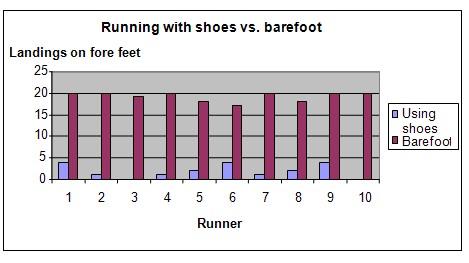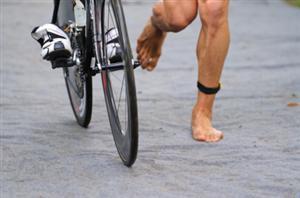| Complexity level: | 8 |
| Project cost ($): | 20 |
| Time required: | 1 hour to prepare, 2 hours for the science project experiment |
| Material availability: | Easily found |
| Safety concerns: | Basic safety requirements |
Hypothesis
Running barefoot will help runners land on the forefeet whereas running with shoes will cause them to land on their heels.
Overview
Running barefoot
Running barefoot means running without wearing any shoes. The human foot is built in such a way that landing on the forefoot (front ball of the feet) while running will enable it to absorb the force of landing, and convert it into a forward motion. Barefoot runners are able to take advantage of this natural “forward-springing” motion because they will always land on the forefoot.
Runners who use shoes are more likely to land on their heels. . This is the reason why running shoes are normally very heavily padded near the heel. Landing on heels will cause the force of the landing to be transmitted through the knees up to the hips. Thus runners using shoes and landing on their heels are very vulnerable to injury.
Running shoes are comfortable and provide protection for the feet but they alter the natural pattern of running using our forefeet. This causes our knees and hips to absorb a force about 2 to 3 times the weight of our bodies!.
Scientific Terms
Materials
The materials required for this science project:
- A running track
- 10 male participants 18 years of age
- A video camera
- 10 pairs of running shoes for the participants
Procedure
1. For this science fair project, the independent variable is the condition of the participant – running with shoes and without shoes. The dependent variable is the number of times the runners land on their forefeet. This is determined by observing the images in the video recording. The constants (control variables) are the temperature of the track, the age of the participants and the gender of the participants.
2. The 10 male runners are each assigned a number 1 to 10 and asked to perform some warm up exercises before the science fair project starts. They will be required to run a distance of 100 meters twice.
3. The video camera is fixed near the 50 meter mark along the running stretch. The distance of the camera from the track should be such that the recording clearly shows up to 10 strides of the runner.
4. For the first science fair project, the 10 runners are made to run 100 meters on the track one person at a time, while wearing shoes. The stride of the runners is recorded in the camera.
5. For the second science fair project, the 10 runners are made to run 100 meters on the track one person at a time, barefoot. They are recorded on camera again.
6. After all the runners have completed the running session, the video recording is played back to see if the runners landed on their fore feet or heels. The first 10 strides are observed and the number of they landed on their forefeet was recorded.

Results
The results show that running barefoot causes runners to land on their forefeet more frequently. The runners with shoes landed on their heels more frequently.
|
Participant’s condition |
Number of landings on fore feet |
|||||||||
|
1 |
2 |
3 |
4 |
5 |
6 |
7 |
8 |
9 |
10 |
|
|
Using shoes |
4 |
1 |
0 |
1 |
2 |
4 |
1 |
2 |
4 |
0 |
|
Barefoot |
20 |
20 |
19 |
20 |
18 |
17 |
20 |
18 |
20 |
20 |
The chart below represents the results of our science experiment.

Conclusion
The hypothesis that running barefoot will help runners land on their forefeet whereas runners with shoes will land on their heels, is proven to be true.
Running barefoot helps us reduce injuries and develop muscles in our feet. However there is also the danger of blisters, stepping on nails, broken glass or other dangerous objects.
Also consider
The science fair project can also be done by running on different surfaces like a field or beach sand.
This science fair project can also be done to compare different types of shoes like jogging shoes, track shoes, etc.
References
Barefoot running - http://en.wikipedia.org/wiki/Barefoot_running
Barefoot running laced with health benefits - http://www.webmd.com/fitness-exercise/news/20100127/barefoot-running-laced-with-health-benefits
Barefoot running – the pros and cons of going shoeless - http://sportsmedicine.about.com/od/runningworkouts/a/Barefoot-Running.htm

